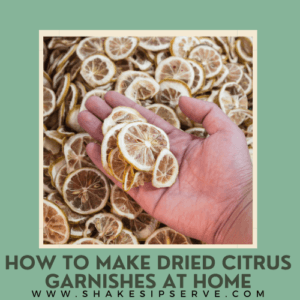How To Make Dried Citrus Garnishes At Home – a simple yet impactful way to take your mixology game to the next level.
Welcome to Shake, Sip, Serve!
Here, we believe every cocktail tells a story, and we’re here to help you shake, sip, and serve your way through the world of creative drinks and unforgettable bar experiences.
Whether you’re an aspiring mixologist, a seasoned bartender, or just someone who loves a perfectly crafted drink, you’ve come to the right place. Grab your shaker and let’s dive into today’s mix—because life’s too short for bad cocktails!
There’s something inherently satisfying about creating your own cocktail garnishes, especially when they add both flavor and flair to your drinks. Enter dried citrus garnishes – a simple yet impactful way to take your mixology game to the next level. But fear not, crafting these elegant garnishes at home is easier than you might think. Let’s break down the process step by step and delve deeper into the art and science of dried citrus garnishes.
The Art and Science of Dried Citrus Garnishes
Choosing Your Citrus
Start by selecting fresh, firm citrus fruits. Lemons, limes, oranges, and grapefruits are all excellent choices, each offering its own unique flavor profile. Aim for fruits that are ripe but still firm, as they will yield the best results.
- Lemons: Known for their bright acidity and vibrant flavor, lemons add a zesty punch to any cocktail.
- Limes: Offering a tangy and slightly bitter profile, limes are perfect for adding complexity to your drinks.
- Oranges: With their sweet and aromatic characteristics, oranges can enhance both the flavor and visual appeal of your cocktails.
- Grapefruits: These fruits bring a balance of sweetness and bitterness, making them ideal for sophisticated cocktails.
Selecting High-Quality Citrus
For the best results, choose organic citrus fruits if possible. Organic fruits are free from pesticides and chemicals that could alter the flavor during the drying process. Look for fruits with bright, unblemished skin and a firm texture.
Slicing the Citrus
Using a sharp knife or a mandoline slicer, carefully slice your citrus fruits into thin, even rounds. Aim for slices that are about 1/8 to 1/4 inch thick. Thinner slices will dry more quickly, while thicker slices may take longer. Ensure uniformity in thickness to promote even drying.
- Precision Cutting: A mandoline slicer can help achieve consistent thickness, which is crucial for even drying.
- Safety Tip: Always use a hand guard or protective glove when using a mandoline to prevent accidents.
Removing Seeds
If your citrus slices contain seeds, carefully remove them with the tip of your knife to prevent them from interfering with the drying process. This step ensures that your garnishes are not only visually appealing but also pleasant to consume.
- Techniques: Use a small paring knife or a toothpick to gently pry out seeds without damaging the slices.
Pre-Treating for Extra Flavor (Optional)
For an extra burst of flavor, you can pre-treat your citrus slices before drying them. Simply soak the slices in a mixture of water and sugar or a citrus-infused syrup for about 10-15 minutes. This step helps to enhance the natural sweetness of the fruit and can add depth to your garnishes.
- Simple Syrup: Make a simple syrup by dissolving equal parts sugar and water over low heat. Add citrus zest or other flavorings for an added twist.
- Spiced Syrup: Consider adding spices like cinnamon, cloves, or star anise to the syrup for a unique flavor profile.
Drying Methods
There are several methods you can use to dry your citrus slices:
Oven Drying
Preheat your oven to its lowest setting (usually around 170°F or 75°C). Place the citrus slices on a parchment-lined baking sheet in a single layer, making sure they don’t overlap. Bake for 2-4 hours, flipping the slices halfway through, until they are completely dehydrated and leathery to the touch.
- Tips for Success: Check the slices periodically to prevent over-drying. Use multiple trays if necessary to avoid overcrowding.

Air Drying
If you prefer a more hands-off approach, you can air dry your citrus slices. Simply arrange them in a single layer on a wire rack or parchment-lined baking sheet, making sure there is plenty of space between each slice for air circulation. Place the rack in a well-ventilated area away from direct sunlight and let the slices air dry for 1-2 days, or until they are fully dehydrated.
- Optimal Conditions: Ensure the drying area is free from dust and pests. Consider using a fan to improve air circulation.
Dehydrator
If you have a food dehydrator, this is perhaps the most efficient method for drying citrus slices. Arrange the slices on the dehydrator trays in a single layer, leaving space between each slice. Set the dehydrator to a low temperature, typically around 135°F (57°C), and let the slices dry for 4-6 hours, or until they are completely dehydrated.
- Benefits: Dehydrators offer precise temperature control and consistent airflow, resulting in evenly dried slices.
- Model Recommendations: Look for dehydrators with adjustable temperature settings and multiple trays to maximize efficiency.
Storing Your Dried Citrus
Once your citrus slices are fully dried, allow them to cool completely before storing them. Store the dried citrus garnishes in an airtight container in a cool, dark place. Properly stored, they can last for several weeks or even months, ready to be used whenever inspiration strikes.
- Airtight Containers: Use glass jars with tight-sealing lids or vacuum-sealed bags to maintain freshness.
- Labeling: Label your containers with the date and type of citrus to keep track of freshness.
Enhancing Cocktails with Dried Citrus Garnishes
Flavor Enhancement
Dried citrus garnishes add more than just a visual appeal to your cocktails. The dehydration process concentrates the flavors, providing a more intense citrus burst that can elevate the overall taste of your drink.
- Infused Flavors: Use dried citrus to infuse spirits and syrups, adding depth and complexity to your cocktails.
- Balancing Act: Pair dried citrus with complementary ingredients to create a balanced flavor profile.
Aesthetic Appeal
The vibrant colors and unique textures of dried citrus slices can transform an ordinary cocktail into a visually stunning masterpiece. Their intricate designs and natural hues make them perfect for Instagram-worthy presentations.
- Garnish Techniques: Float slices on the surface of drinks, hang them on the rim, or arrange them on skewers for creative garnishing.
- Presentation Tips: Consider using edible flowers, herbs, and other decorative elements alongside dried citrus for a more elaborate presentation.
Versatile Uses
Dried citrus garnishes are incredibly versatile and can be used in various ways to enhance your cocktails:
- Rimming Glasses: Crush dried citrus slices and mix with sugar or salt to create flavorful glass rims.
- Cocktail Syrups: Simmer dried citrus in simple syrup to infuse it with concentrated flavors.
- Ice Cubes: Freeze dried citrus slices in ice cubes for a slow-release flavor addition.
The Historical Context of Cocktail Garnishes
Early Origins
Cocktail garnishes have a rich history, evolving from simple functional additions to elaborate decorative elements. In the early days, garnishes were used primarily for their practical benefits, such as adding acidity or masking unpleasant flavors.
- Lemon and Lime Wedges: These were among the first garnishes used to enhance the taste of spirits and provide a refreshing touch.
Prohibition Era
During the Prohibition era, speakeasies and underground bars thrived, leading to a surge in cocktail creativity. Bartenders began experimenting with more intricate garnishes to enhance both the flavor and visual appeal of their drinks.
- Fruit Peels and Twists: These became popular for their aromatic oils and striking appearance.
Modern Mixology
Today, garnishes have become an essential part of cocktail presentation. Mixologists use them to add flavor, aroma, and a touch of artistry to their creations. Dried citrus garnishes, in particular, have gained popularity for their versatility and aesthetic appeal.
- Edible Art: Modern garnishes are often designed to complement the drink’s theme and ingredients, turning cocktails into edible art.
Exploring the Science Behind Dried Citrus
Dehydration Process
The process of dehydrating citrus slices involves removing water content, which concentrates the fruit’s natural flavors and sugars. This intensification of flavors is what makes dried citrus such a powerful garnish.
- Flavor Concentration: Dehydration reduces the water content, leaving behind concentrated flavors and aromas.
- Sugar Preservation: Natural sugars in the fruit become more pronounced, adding a subtle sweetness to the garnish.
Nutritional Retention
While some vitamins may be lost during the drying process, many of the beneficial compounds, such as antioxidants and flavonoids, remain intact. These compounds contribute to the flavor and potential health benefits of dried citrus.
- Antioxidants: Dried citrus retains antioxidants, which can add a healthful element to your cocktails.
- Flavonoids: These compounds provide both flavor and health benefits, such as anti-inflammatory properties.
Advanced Techniques for Dried Citrus Garnishes
Creating Smoky Citrus Cocktails
Combine dried citrus slices with a smoking gun to infuse your cocktails with a smoky aroma. This technique adds a layer of complexity and sophistication to your drinks.
- Smoked Old Fashioned: Place a dried orange slice on top of the drink, cover the glass, and use a smoking gun to fill it with smoke. Let it sit for a few moments to infuse.
Infusing Spirits
Add dried citrus slices to bottles of spirits like vodka, gin, or tequila to create custom-infused liquors. Allow the flavors to meld for a few days before using the spirits in cocktails.
- Custom Infusions: Experiment with different citrus combinations to create unique flavor profiles.
Making Citrus Ice Cubes
Freeze dried citrus slices in ice cubes to slowly release flavors into your drink as the ice melts. This method provides a gradual infusion and keeps your cocktail chilled.
- Citrus Ice Cubes: Place a dried citrus slice in each compartment of an ice cube tray, fill with water, and freeze.
Combining Dried Citrus with Fresh Ingredients
Pair dried citrus with fresh herbs, spices, and other fruits to create multi-dimensional garnishes. This combination can add both visual interest and flavor complexity to your cocktails.
- Herb and Citrus Garnishes: Combine dried citrus with fresh mint, basil, or rosemary for an aromatic touch.
Exploring Non-Alcoholic Applications
Enhancing Mocktails
Dried citrus garnishes can add sophistication to non-alcoholic beverages, making them just as exciting as their alcoholic counterparts.
- Virgin Mojito: Garnish with a dried lime slice and fresh mint for a refreshing twist.
Infused Waters
Elevate your daily hydration by adding dried citrus slices to your water bottle. The slices will infuse the water with a subtle citrus flavor, encouraging you to drink more throughout the day.
- Flavor Combinations: Try a mix of dried lemon, lime, and orange slices for a complex flavor profile.
Sustainable Practices in Dried Citrus Production
Reducing Food Waste
Using dried citrus garnishes is an excellent way to reduce food waste. By dehydrating fruit that might otherwise spoil, you can extend its shelf life and minimize waste.
- Eco-Friendly Approach: Incorporate dried citrus into your sustainable bartending practices.
Supporting Local Farmers
Sourcing citrus from local farmers can support the local economy and reduce the environmental impact associated with long-distance transportation.
- Farm-to-Glass: Embrace the farm-to-glass movement by using locally sourced, organic citrus.
The Future of Cocktail Garnishing
Technological Innovations
Advancements in dehydration technology could lead to even more creative uses of dried citrus. Precision dehydration methods might allow for the preservation of even more flavor and nutrients, resulting in superior quality garnishes.
- Cutting-Edge Dehydrators: Keep an eye on new dehydrator models with enhanced capabilities.
Customization and Personalization
The trend towards personalized experiences in dining and drinking could see the rise of custom dried citrus garnishes. Imagine being able to order a cocktail with a garnish that has been specifically dried to your taste preferences, or even branded with a logo or message.
- Bespoke Garnishes: Offer personalized garnishes for special events or themed parties.
Conclusion: Embracing the Innovation of Dried Citrus
The benefits of using dried citrus in cocktails are undeniable. From their extended shelf life and intensified flavor profile to their consistent quality, versatility, and aesthetic appeal, dried citrus garnishes offer a multitude of advantages for both professional bartenders and home cocktail enthusiasts. So, why not embrace this innovative approach to garnishing? Experiment with different citrus fruits and explore various presentation techniques to discover new and exciting ways to elevate your favorite cocktails. With dried citrus as your partner, the possibilities for crafting exceptional and visually stunning drinks are endless. Cheers to raising the bar on cocktail culture, one beautifully adorned and flavor-infused drink at a time!
Practical Tips for Home Bartenders
Starting Small
If you’re new to drying citrus, start with small batches to refine your technique and discover your preferred methods.
- Trial and Error: Experiment with different drying times and temperatures to achieve the perfect result.
Sharing with Friends
Dried citrus garnishes make great gifts for fellow cocktail enthusiasts. Package them in decorative jars or bags for a thoughtful and unique present.
- Gift Ideas: Include a recipe card with cocktail suggestions that feature the dried citrus garnishes.
Documenting Your Creations
Keep a journal or photo log of your dried citrus creations and the cocktails you use them in. This can help you track your experiments and refine your techniques over time.
- Creative Journaling: Document the drying process, flavor notes, and presentation ideas for future reference.
Expanding Your Citrus Selection
Don’t limit yourself to just lemons, limes, oranges, and grapefruits. Explore other citrus varieties like blood oranges, tangerines, and kumquats to add even more diversity to your garnishes.
- Exotic Citrus: Experiment with lesser-known citrus fruits to create unique and intriguing garnishes.
Embracing the Community
Join online forums and social media groups dedicated to mixology and garnishing. Sharing your experiences and learning from others can provide inspiration and help you refine your skills.
- Online Communities: Engage with fellow enthusiasts on platforms like Instagram, Pinterest, and Reddit to share tips and showcase your creations.
By mastering the art of dried citrus garnishes, you can transform your home bartending experience and impress your guests with beautifully crafted, flavorful cocktails. So, gather your citrus fruits, fire up your dehydrator (or oven), and embark on a journey of culinary creativity.
Thanks for joining us behind the bar! Whether you’re crafting for yourself or shaking things up for friends, remember: it’s not just about the drink, but the memories we make while we sip. Keep experimenting, keep pouring with love, and don’t forget to check back at Shake, Sip, Serve for more inspiration. Cheers to the next round!
Your Favourite Bartender KAD xo
Disclaimer: This post contains affiliate links. If you purchase through these links, I may earn a small commission at no additional cost to you.
Check out more :
- Introduction to Dried Citrus Garnishes
- Benefits of Using Dried Citrus in Cocktails
- How to Make Dried Citrus Garnishes at Home
- Creative Cocktail Recipes with Dried Citrus Garnishes
- Classic Gin and Tonic with Dried Lemon Wheel
- Citrus Old Fashioned with Dried Orange Twist
- Dried Lime Margarita
- Blood Orange Martini with Dried Citrus Zest
- Tips for Garnishing Cocktails with Dried Citrus
- Dried Citrus Garnishes: Elevate Your Cocktails with a Touch of Class.
- Elevate Your Cocktails with Dried Citrus Garnishes
